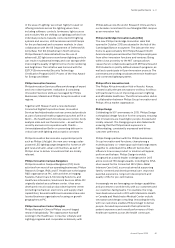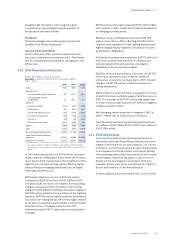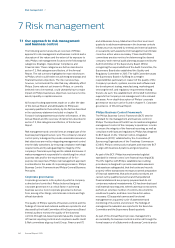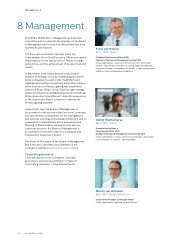Philips 2015 Annual Report Download - page 67
Download and view the complete annual report
Please find page 67 of the 2015 Philips annual report below. You can navigate through the pages in the report by either clicking on the pages listed below, or by using the keyword search tool below to find specific information within the annual report.Risk management 7.2
Annual Report 2015 67
covered in section 7.7, Separation risk, of this Annual
Report. Philips is prudent with regard to nancial risks
and the risk appetite is embedded in various chapters
of this annual report, including note 31, Details of
treasury / other nancial risks.
Philips describes the risk factors within each risk category in
order of Philips’ current view of expected significance, to give
stakeholders an insight into which risks and opportunities it
considers more prominent than others at present. The risk
overview highlights the main risks and opportunities known
to Philips, which could hinder it in achieving its strategic and
financial business objectives. The risk overview may,
however, not include all the risks that may ultimately affect
Philips. Describing risk factors in their order of expected
significance within each risk category does not mean that a
lower listed risk factor may not have a material and adverse
impact on Philips’ business, strategic objectives, revenues,
income, assets, liquidity, capital resources or achievement
of Philips’ 2016 goals. Furthermore, a risk factor described
after other risk factors may ultimately prove to have more
significant adverse consequences than those other risk
factors. Over time Philips may change its view as to the
relative significance of each risk factor.
7.3 Strategic risks
As Philips’ business is global, its operations are exposed
to economic and political developments in countries
across the world that could adversely impact its
revenues and income.
Philips’ business environment is inuenced by political
and economic conditions in the domestic and global
markets. Philips experienced the impact from changes
in macro-economic development in various
geographies during 2015 in particular in China where
economic growth was at the lowest level in the last 25
years. This has triggered interventions by the Chinese
government on the ocial exchange rate of the Chinese
Renminbi. Also the economic growth of countries highly
dependent on revenues from energy, raw materials and
commodities has been adversely aected by the
slowdown of growth in China, most strongly in
emerging market countries. Monetary interventions by
the European Central Bank have not yet resulted in an
increase of ination nor in stronger economic growth in
the European Union. The disparate macroeconomic
outlook for the main geographies, political conicts and
the unknown impact of Eurozone monetary policy
continues to provide uncertainty on the levels of capital
expenditures in general, unemployment levels and
consumer and business condence, which could
adversely aect demand for products and services
oered by Philips. These economic conditions may
have an adverse eect on nancial markets which could
aect the ability of Philips to sell o strategic
divestments at reasonable price levels or within a
reasonable period of time.
The general global political environment remains
unfavorable for the business environment due to a rise in
political conflicts and terrorism. Numerous other factors, such
as sustained lower levels of energy and raw material prices,
regional political conflicts in the Middle East, Russia and
Ukraine and other regions, as well as large-scale
(in)voluntary migration and profound social instability could
continue to impact macroeconomic factors and the
international capital and credit markets. Economic growth
and the business environment in the European Union may
be adversely affected by potential exits from the Eurozone
(Greece), exits from the European Union (Great Britain) or
secession of regions from European countries (e.g. Cataluña
and Scotland). Economic and political uncertainty may have
a material adverse impact on Philips’ financial condition or
results of operations and can also make it more difficult for
Philips to budget and forecast accurately. Philips may
encounter difficulty in planning and managing operations
due to the lack of adequate infrastructure and unfavorable
political factors, including unexpected legal or regulatory
changes such as foreign exchange import or export controls,
increased healthcare regulation, nationalization of assets or
restrictions on the repatriation of returns from foreign
investments. Given that growth geographies are increasingly
important in Philips’ operations, the above-mentioned risks
are also expected to grow and could have a material adverse
effect on Philips’ financial condition and operating results.
Philips may be unable to adapt swiftly to changes in
industry or market circumstances, which could have a
material adverse impact on its nancial condition and
results.
Fundamental shifts in the industry, like the transition
from traditional lighting to LED lighting, may drastically
change the business environment. If Philips is unable to
recognize these changes in good time, is late in
adjusting its business models, or if circumstances arise
such as pricing actions by competitors, then this could
have a material adverse eect on Philips’ growth
ambitions, nancial condition and operating result.
Philips’ overall performance in the coming years is
dependent on realizing its growth ambitions in growth
geographies.
Growth geographies are becoming increasingly important in
the global market. In addition, Asia is an important
production, sourcing and design center for Philips. Philips
faces strong competition to attract the best talent in tight
labor markets and intense competition from local companies
as well as other global players for market share in growth
geographies. Philips needs to maintain and grow its position
in growth geographies, invest in local talents, understand
developments in end-user preferences and localize the
portfolio in order to stay competitive. If Philips fails to achieve
this, then this could have a material adverse effect on growth
ambitions, financial condition and operating result.
























